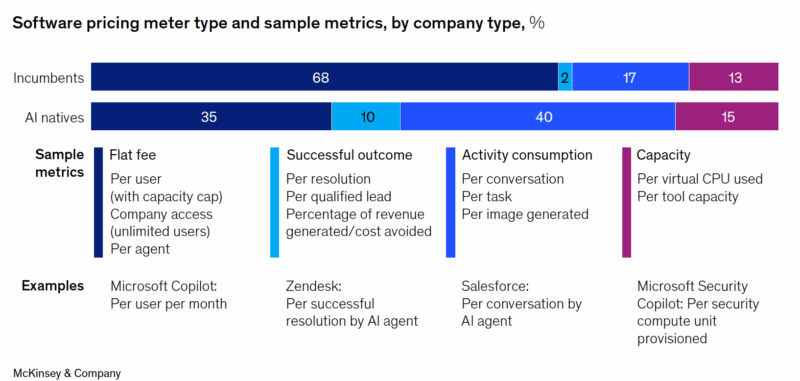
The rush to embed AI into every layer of business software has created a new reality for enterprise buyers: AI is now a line item — and an expensive one. Software that once enabled work now promises to perform it. The pitch sounds irresistible.
Vendors cite multitrillion-dollar productivity gains and talk of a “new super cycle” of innovation. However, for many organizations, those promises have yet to yield measurable returns, according to a new report from McKinsey. Instead, AI has introduced a new source of budget pressure and uncertainty.
Across the market, existing software products are getting AI capabilities — often with higher price tags attached. McKinsey estimates that AI functionality can drive list price increases of 60%–80% in some categories, particularly in customer service, analytics and CRM.
The problem: most organizations haven’t realized equivalent cost savings or productivity gains. What was marketed as efficiency has, so far, proven to be an inflationary force in IT budgets.
The rising cost of ‘AI everywhere’
“AI is showing up everywhere in our stack, but I can’t point to where it’s saving us money,” one enterprise CIO said in the report “Upgrading software business models to thrive in the AI era.” “We’re spending more without a clear sense of what we’re getting back.”
Dig deeper: How to measure your CreativeOps maturity to unlock performance
Many companies talk about what AI could do, but very few can show what it’s actually doing. The report found that only about 30% have shared real, dollar-based ROI from customer deployments. The report singles out Salesforce as one of the companies getting it right. Its Agentforce ROI Calculator can show, in hard numbers, how AI-powered service agents cut costs compared to human teams. That kind of proof leaves less guesswork for buyers and helps close deals faster—no lengthy pilot needed.
The hidden costs of complexity
McKinsey found that many customers are also struggling with AI’s pricing opacity. Predictability — a cornerstone of SaaS contracts — is eroding as AI-driven features are priced based on usage metrics, API calls or “credits.”
“It’s frustrating. We don’t have a clear forecast for what our organization will spend on AI because the cost is distributed across dozens of tools,” said a Fortune 500 CFO quoted in the report.
This lack of clarity leaves buyers funding what increasingly feels like an open-ended experiment. Without standardized pricing or transparent ROI reporting, customers shoulder the risk while vendors collect early returns.

McKinsey is not the only firm reporting about this. At a conference in Australia last month, Jo Liversidge, a Gartner vice president and analyst, said that vendors aren’t making it easy to find the cost of AI. She pointed out that AWS only addresses AI in clause 50 of its supplementary T&C documents.
“Hidden costs are not new in SaaS – Salesforce customers have dealt with storage costs for years,” she said. “But we’re now seeing a proliferation of hidden costs, particularly around generative AI capabilities.
Livsersidge pointed out that some AI vendors make you pre-pay for your usage. Instead of paying as you go, you purchase a block of “usage rights” or credits upfront. Then, they apply different “multipliers,” which means certain services cost you more credits than others.
Efficiency without downsizing
A central promise of AI — that it will enable companies to “do more with less” — remains largely unfulfilled. GenAI assistants and “copilots” are meant to automate routine tasks, freeing employees for higher-value work. But few organizations report meaningful labor savings.
The McKinsey report quotes one HR executive at a Fortune 100 company, “All of these copilots are supposed to make work more efficient with fewer people, but my business leaders are also saying they can’t reduce head count yet.”
Dig deeper: 5 ways MOps can stop order-taking and start driving strategy
In some industries, low-cost human labor remains more economical than automation, undercutting the case for AI-driven efficiency.
What customers can do
Enterprise buyers are not powerless in this shift. As AI capabilities become a default feature of business software, customers can and should demand more evident proof of value and tighter alignment between pricing and performance.
- Ask for quantifiable ROI. Before renewing or upgrading contracts, require vendors to provide data linking AI usage to measurable outcomes such as cost reduction, revenue lift or time savings.
- Demand pricing transparency. Push for predictable billing structures that reflect business outcomes — not vague metrics like “AI credits” or model calls. If costs are variable, vendors should provide precise consumption forecasts.
- Budget for adoption, not just licenses. Successful AI implementation often requires training, workflow redesign and employee education and adoption. The McKinsey report says, “A good rule of thumb is that for every $1 organizations spend on model development, they should expect to have to spend $3 on change management.”
- Insist on pilot-to-production accountability. Many AI tools deliver impressive pilot results that fail to scale. Make post-pilot performance reporting part of the contract.
The bottom line
AI promises to be transformational — but the transformation should be mutual. Customers deserve evidence that AI investments deliver measurable gains, not just new costs.
Until vendors can demonstrate that AI reduces labor, improves efficiency, or creates new business capacity, buyers would be wise to treat AI premiums as provisional, not permanent.
Because for now, the real intelligence in enterprise AI may lie in the questions customers ask — not the algorithms they pay for.
The post AI productivity gains, like vendors’ AI surcharges, are hard to find appeared first on MarTech.